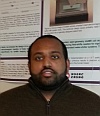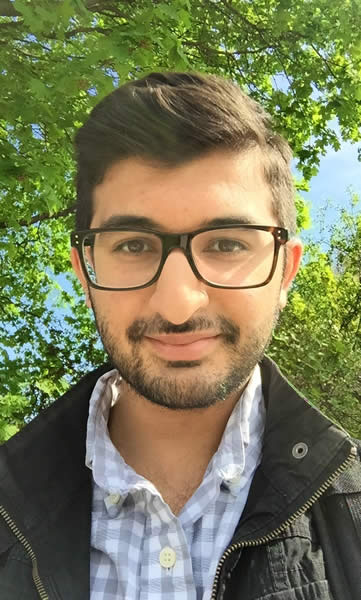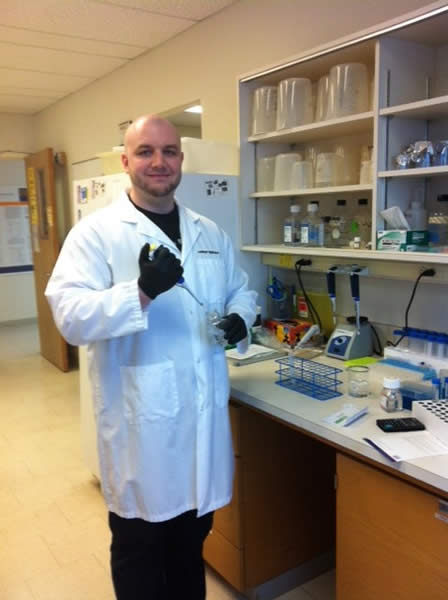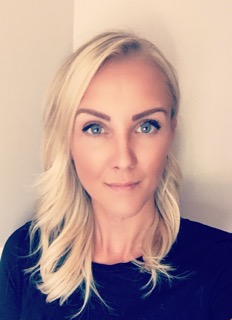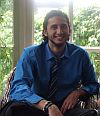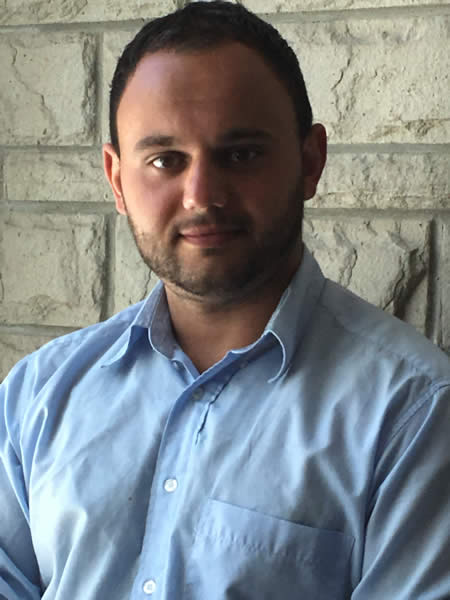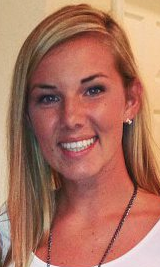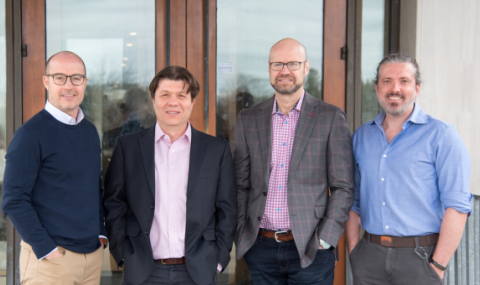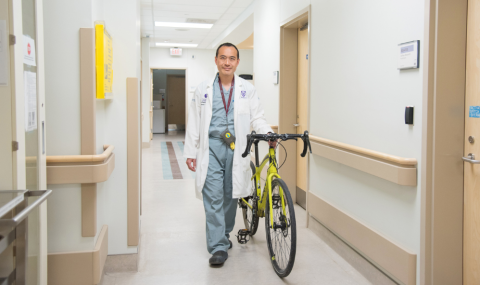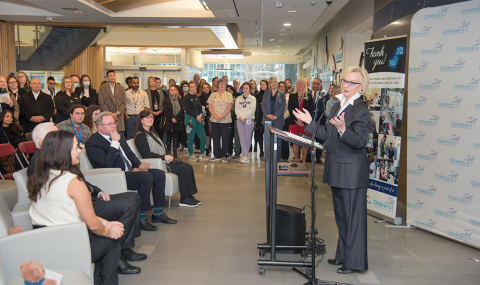| Yonathan Araya is a PhD student in the Department of Medical Biophysics, under the supervision of Dr. Timothy Scholl. Yonathan is currently investigating the uptake, penetration, homogeneity, and distribution of serum albumin in breast cancer tumours. The albumin-SPARC (secreted protein acidic and rich in cysteine)-glycoprotein 60 pathway has been shown as a marker for angiogenic blood vessels in breast cancer tumours. Using a novel magnetic resonance field-cycling imaging method, called delta relaxation-enhanced magnetic resonance (dreMR), and the targetable contrast agent Albavar, he proposes to evaluate albumin trafficking to improve the early detection capabilities of aggressive breast cancer phenotypes. dreMR imaging will improve current clinical limitations for protein based MR imaging. | |
| Alexandra Hauser-Kawaguchi is a PhD student in the Department of Chemistry, under the supervision of Dr. Len Luyt. Receptor for hyaluronan mediated motility (RHAMM) is one of the biological receptors for hyaluronan (HA), a large carbohydrate that is associated with breast cancer progression. RHAMM is associated with breast cancer progression, metastasis, and relapse of the disease. We have synthesized a truncated version of the receptor, 7 kDa RHAMM, by chemical methods, and have shown that it is a suitable replacement receptor for screening new peptide ligands that we discover. In addition, we have developed RHAMM peptide mimics that block normal RHAMM function in cells, and are less likely to be broken down by the body. We are currently investigating them for their therapeutic and diagnostic potential in RHAMM-expressing breast cancer. | |
| Sami Khan is an MSc student in the Department of Anatomy and Cell Biology, under the supervision of Dr. Alison Allan. The process by which cancers spread to other organs is known as metastasis, and it accounts for the majority of breast cancer patient deaths as currently available treatments are largely ineffective in the metastatic setting. Recent findings from their lab suggest that the CD44 cell-surface receptor expressed by breast cancer cells may play an important role in promoting metastasis by interacting with organ-specific proteins. Sami’s research is focused on assessing lung-specific ligands for the CD44 receptor as novel targets for the treatment and prevention of breast cancer metastasis. | |
| Bart Kolendowski is a PhD student working under the supervision of Dr.Torchia at the London Regional Cancer Program and is in the department of Biochemistry at Western University. His work focuses on the estrogen receptor (ER) which is a hormone receptor that is expressed in most breast cancers and is the target of certain breast cancer therapies, including tamoxifen. Understanding how the ER drives tumour growth is paramount in understanding how endocrine therapies work and what happens when they fail. Bart is using global genome-wide approaches to identify long noncoding RNAs (lncRNA) which are regulated by ER and may represent novel driving factors in breast cancer. By investigating the role of ER in regulating the production of these lncRNA, Bart plans on furthering our understanding of why hormonal therapies fail while at the same time developing a targeted therapy approach for breast cancer. | |
| Milica Krstic is a PhD student in the Department of Pathology, under the supervision of Dr. Alan Tuck and Dr. Ann Chambers. Her project examines the mechanistic role of transcription factor TBX3 in the “malignant conversion” of breast cancer cells. Conversion of breast cancer from a non-invasive to invasive type is associated with morbidity and mortality of the disease, and remains the greatest concern for patients. She will also quantify expression of TBX3 in clinical samples of premalignant vs. early invasive stage breast cancer. This work will help to determine if TBX3 can predict which premalignant lesions of the breast are most likely to progress, allowing us to stratify patients into high-risk and low-risk groups, which could potentially affect subsequent treatment strategies. Additionally, this work has the potential to identify new targets for breast cancer therapy, hence preventing metastasis. | |
| Ashley Makela is a PhD student working under the supervision of Dr. Paula Foster in the Department of Medical Biophysics. We investigate tumour associated macrophages (TAMs), which are cells within the tumour – their presence helps the tumour grow, allows the cancer to spread to other sites in the body (metastasize) and they are associated with a poor prognosis in the majority of breast cancer cases. These cells can be detected and monitored by utilizing high-resolution magnetic resonance imaging (MRI) methods along with the use of cell labeling agents. This research may produce important information about the influence of TAMs on tumour growth and metastatic spread and give insight on how to use this information to aid in detection, prognosis and treatment evaluation. | |
| Justin Michael is an MESc student in the Biomedical Engineering program, under the supervision of Dr. Aaron Fenster. Justin’s research aims to develop guidance tools for an alternative, single-visit radiation treatment that implants radioactive “seeds” directly into the breast. Breast cancer patients often require lengthy radiation therapy and for patients who live far from treatment facilities this length may cause some to choose a mastectomy to avoid lengthy therapy even if it is not their first choice. He intends to develop an imaging system using ultrasound to provide 3D image guidance during the surgery in the hopes of making this alternative, single-visit treatment more widely available and increasing access to care for rural patients. | |
| Matthew Mouawad is a PhD Student in the Department of medical biophysics, under the supervision of Dr. Stewart Gaede and Dr. Neil Gelman. His work will contribute to the development and optimization of a proposed new treatment plan for early stage breast cancer using a single treatment of radiation prior to lumpectomy instead of the current standard of care which is whole breast radiotherapy following surgery. This proposed treatment has the potential to drastically improve the quality of life for breast cancer patients by reducing radiotherapy treatment time from several weeks to a single session. Using the only imaging system in Canada that combines the functionality of PET and MRI, he will assess the potential of this imaging system to evaluate patient tumor response to radiation. This research will lead to the development of tools to help clinicians to tailor treatment regiments to individual patients. | |
| Tomi Nano is a PhD-MCISc (CAMPEP) student in the Department of Medical Biophysics, under the supervision of Dr. Ian Cunningham. They are developing novel diagnostic imaging tools ensuring the benefits of each procedure outweigh the risks and contribute to patient well-being. Women who enroll in mammography screenings have up to 40% reduced risk of death from breast cancer, but could be at an increased risk of cancer from exposures to radiation. We aim to develop an “ideal” x-ray detector which produces the highest quality images using minimum radiation exposure for mammography screening purposes. Systems that provide high quality images result in increased detection rates, which we hope lead to earlier detection and more effective breast cancer treatment outcomes. | |
| Katie Parkins is an PhD student in the Department of Medical Biophysics, under the supervision of Dr. Paula Foster and Dr. John Ronald. Her project involves the use of molecular imaging techniques to determine if the presence of a primary breast cancer tumour can suppress the development of brain metastases by inducing tumour cell dormancy. Understanding the mechanism(s) by which this physiological inhibition of metastatic outgrowth can occur may lead to new therapeutic approaches to enhance dormancy or maintain dormant cancer in a nonproliferative state. | |
| Ashkan Sadri is an MSc student in the Department of Anatomy and Cell Biology, under the supervision of Dr. Alison Allan. Despite rigorous research revolving around the topic, breast cancer still remains a leading cause of cancer-related death amongst Canadian women. The primary factor that causes this is metastasis (the spread of cancer cells from the primary breast tumor to distant organs), since current therapies are largely non-curative in the metastatic setting. Our novel study aims to identify key factors involved in metastasis towards the lung and bone microenvironments, as these particular tissues are clinically important sites of breast cancer dissemination. Recently, we have observed that specific organ microenvironments reduce the ability for breast cancer cells to adhere (stick down) to the cell culture dish, resulting in a distinct “floating” cell population that is still capable of growing. Our further investigations are aimed at determining whether these “floating” cells may have enhanced stem-like and aggressive activity compared to their adherent counterparts. Understanding these intra- and extracellular communications are directly translational to the prevention of metastatic disease related to breast cancer. | |
| Olivia Tong is an MSc student in the Biomedical Engineering Program, under the supervision of Drs. Jeffrey Carson and Mamadou Diop. She is working on a non-contact scanner that can accurately monitor the blood oxygen level inside tumours during chemotherapy. The results from the project will lead to a new diagnostic method that can quickly identify the most effective drug for each breast cancer patient receiving chemotherapy. | |
| Lawrence Yip is an MSc student in the Department of Medical Biophysics, under the supervision of Dr. Jeffrey Carson. He is working on developing a photoacoustic imaging system, which is a hybrid system combining the advantages of ultrasound and optical imaging. With this system, we hope to assist in breast-conserving surgery to more accurately remove tumourous tissue and reduce repeat surgeries. |

